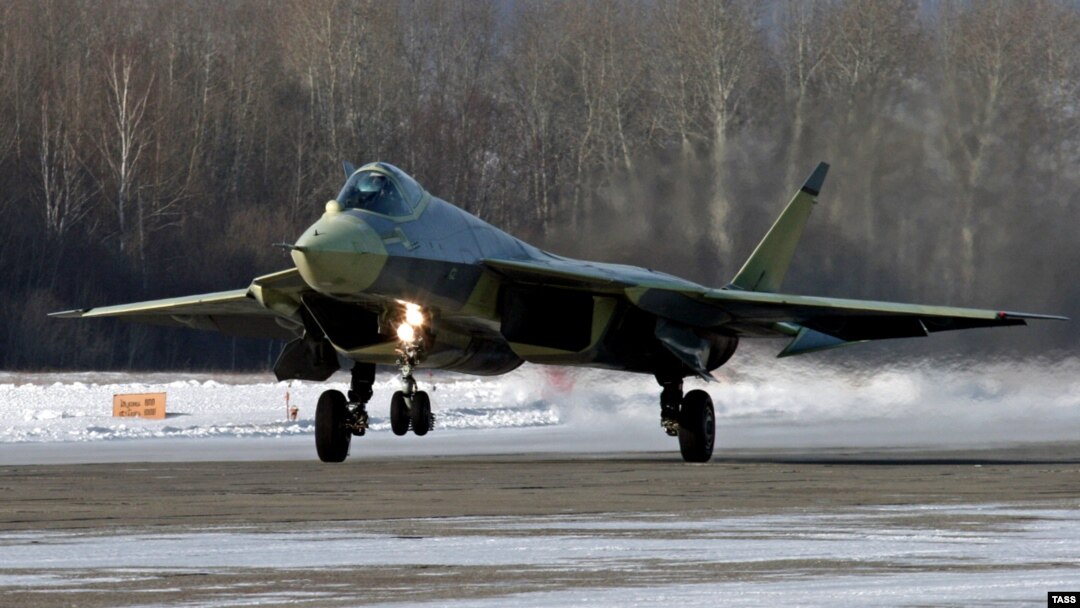MOSCOW (Reuters) -- Russia's fifth-generation stealth jet fighter will be ready for use in 2015, its designer said, as Prime Minister Vladimir Putin pressed the aviation industry to design a new strategic bomber.
Moscow is scrambling to update its aging fleet of military aircraft. It test-flew a long-awaited stealth fighter at the end of January, presenting it as Moscow's first all-new warplane since the 1991 Soviet collapse and a challenge to the technological supremacy of its Cold War foe the United States.
Asked to compare his brainchild to the U.S. F-22 Raptor, built more than a decade ago, the Russian jet's chief designer Alexander Davydenko told reporters: "The basic features are the same but we tried to do it better."
He said Sukhoi, which produced the T-50 prototype of the jet, had simulated duels with the U.S. stealth fighter.
"I think we will have a competitive price. As for the efficiency-and-cost ratio, we will be much better," Davydenko said.
The first MiG-29 and Su-27 prototypes of the previous fourth generation took to the air in 1977. Analysts say several nations, including Libya and Vietnam, had expressed interest in the fifth-generation fighter.
Putin, who toured Sukhoi's design bureau in Moscow on March 1, said Russia still had much work to do before it starts producing the plane.
"Before this machine can go into serial production, there are over 2,000 test flights left. There is still a lot of work ahead," he told a government meeting on the aviation industry.
Putin Wants New Bomber
Putin also urged the industry to begin designing a new bomber.
"We should not confine ourselves to developing just one new model. After the fifth-generation fighter jet, we must think and get down to work on a next-generation, long-range aviation complex -- our new strategic missile carrier," Putin said.
Russia has a large fleet of Soviet-era Tu-95MS turbo-prop strategic bombers codenamed "Bears" by NATO. It has a much smaller number of more modern, supersonic Tu-160 "Blackjack" jet bombers, the world's biggest warplanes ever built.
Sukhoi CEO Mikhail Pogosyan said he saw his company's market share growing from 13 percent of the estimated global $200 billion market in 2006-15 to 15-16 percent of the $300 billion market in 2016-25.
He said three more experimental fighters would be built by the start of next year. Davydenko said 2015 was the deadline for delivering the plane to the armed forces.
Analysts from the Moscow-based Center for Analysis of Strategies and Technologies (CAST) said in a survey published last week that the T-50 prototype's engines did not measure up to new-generation fighters in terms of thrust-to-weight ratio and fuel economy.
The T-50 will also be produced in a 50/50 joint venture with India and could be armed with jointly made BrahMos supersonic cruise missiles, Davydenko said.
Moscow is scrambling to update its aging fleet of military aircraft. It test-flew a long-awaited stealth fighter at the end of January, presenting it as Moscow's first all-new warplane since the 1991 Soviet collapse and a challenge to the technological supremacy of its Cold War foe the United States.
Asked to compare his brainchild to the U.S. F-22 Raptor, built more than a decade ago, the Russian jet's chief designer Alexander Davydenko told reporters: "The basic features are the same but we tried to do it better."
He said Sukhoi, which produced the T-50 prototype of the jet, had simulated duels with the U.S. stealth fighter.
"I think we will have a competitive price. As for the efficiency-and-cost ratio, we will be much better," Davydenko said.
The first MiG-29 and Su-27 prototypes of the previous fourth generation took to the air in 1977. Analysts say several nations, including Libya and Vietnam, had expressed interest in the fifth-generation fighter.
Putin, who toured Sukhoi's design bureau in Moscow on March 1, said Russia still had much work to do before it starts producing the plane.
"Before this machine can go into serial production, there are over 2,000 test flights left. There is still a lot of work ahead," he told a government meeting on the aviation industry.
Putin Wants New Bomber
Putin also urged the industry to begin designing a new bomber.
"We should not confine ourselves to developing just one new model. After the fifth-generation fighter jet, we must think and get down to work on a next-generation, long-range aviation complex -- our new strategic missile carrier," Putin said.
Russia has a large fleet of Soviet-era Tu-95MS turbo-prop strategic bombers codenamed "Bears" by NATO. It has a much smaller number of more modern, supersonic Tu-160 "Blackjack" jet bombers, the world's biggest warplanes ever built.
Sukhoi CEO Mikhail Pogosyan said he saw his company's market share growing from 13 percent of the estimated global $200 billion market in 2006-15 to 15-16 percent of the $300 billion market in 2016-25.
He said three more experimental fighters would be built by the start of next year. Davydenko said 2015 was the deadline for delivering the plane to the armed forces.
Analysts from the Moscow-based Center for Analysis of Strategies and Technologies (CAST) said in a survey published last week that the T-50 prototype's engines did not measure up to new-generation fighters in terms of thrust-to-weight ratio and fuel economy.
The T-50 will also be produced in a 50/50 joint venture with India and could be armed with jointly made BrahMos supersonic cruise missiles, Davydenko said.


